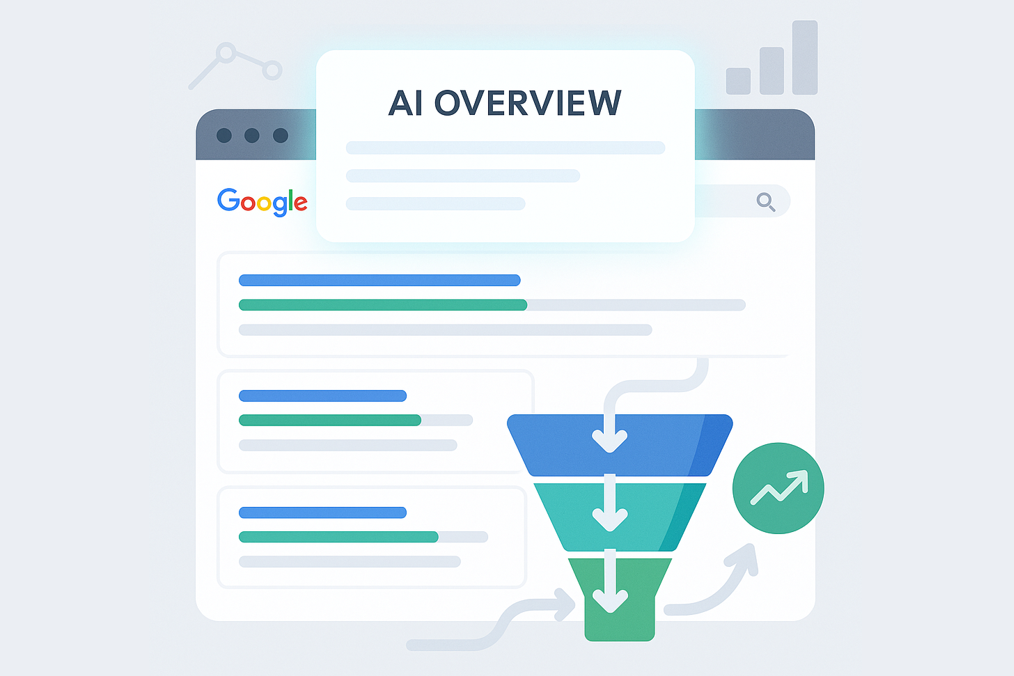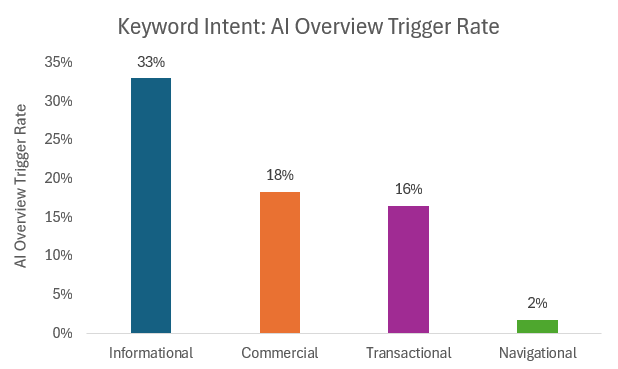
Google’s AI Overviews have fundamentally changed the search engine landscape, and many digital marketers are struggling to understand their impact. If you’ve noticed unusual patterns in your search traffic, this new SERP feature may be the culprit.
The good news? These changes aren’t necessarily hurting your business. In fact, understanding how to measure and optimize for AI overviews can give you visibility in premium SERP real estate. The key is knowing what to look for and how to adapt your measurement strategy in this new era of SEO.
What Are AI Overviews and Why Do They Matter?
AI Overviews (AIOs) are Google’s AI-generated summaries that appear near the top of search results. Unlike featured snippets that pull from one source, AI Overviews synthesize information from multiple websites to provide comprehensive answers to user queries. This allows Google to provide more balanced and complete answers that users may trust more than featured snippets.
This change has the potential to alter user behavior significantly. Users are now more likely to find satisfying answers directly in search results without needing to click through to websites, creating more zero-click searches across a wider range of topics.
How AI Overviews Impact Different Types of Queries
While AIOs are changing user behavior across search, the impact varies depending on what the searcher is trying to accomplish. To properly measure AIO effects on your business, you need to understand how they influence different stages of the customer journey.

Informational queries (top-of-funnel) experience the highest AIO trigger rates, with our data showing 33% of informational keywords triggering the SERP feature. These queries also have significantly lower click-through rates, as users often find their answers directly within the overview without needing to visit additional websites.
Because of this, zero-click searches have become more prevalent, making it more important to track new metrics such as brand mentions. A brand mention occurs any time your company’s name appears inside an AI Overview, even if there isn’t a direct citation link.
Brand mentions matter because they build authority and brand recall in the awareness stage. This can lead to more branded searches and direct traffic over time, even when the first search doesn’t result in a click.
Commercial and transactional queries (middle-of-funnel) present the biggest opportunity for AI Overview influence. When users are evaluating options, AIO visibility can significantly influence their shortlist. Being featured alongside competitors in these summaries is extremely valuable, as it can introduce your business to prospects and provide context about your offerings in a way that a traditional SERP listing cannot.
Navigational queries (bottom-of-funnel) have the lowest AIO trigger rates, at only 2% across our data set. Users who are ready to buy are more likely to click through to a site, making traditional SEO strategies still highly effective for these high-intent searches.
The first step to understanding how AIOs are impacting your search performance is segmenting ranking queries by funnel stage. A decline in top-of-funnel traffic may be offset by improved brand authority and middle-of-funnel influence that drives qualified traffic over time.
How to Identify AI Overview Impact in Your Analytics
Google has not yet provided segmentation for AI Overview performance in any of their reporting tools, making it difficult to directly understand how AIOs are impacting search performance.
Google Search Console data blends AI mode, AI Overviews, and traditional search results into the same impression and click metrics. Similarly, Google Analytics lumps all traffic sources together under “Organic Search” without distinguishing between users who interacted with AI Overviews versus traditional results. In Google Ads, you can identify which campaigns are eligible to show ads in AI Overview placements, but there’s no dedicated reporting for AIO traffic yet.
This lack of segmented reporting means we must analyze overall search metrics to infer AI Overview impact.
Organic search performance indicators:
In Google Search Console:
- Increased impressions across any query that is triggering an AI Overview
- Lower click-through-rates across informational queries
In Google Analytics:
- Traffic declines for blog posts, guides, and educational content
- Stable conversion volume from high-intent users
Paid search performance indicators:
If using broad match, Performance Max, or AI Max campaigns (eligible for AI Overview placements)
- High impressions but lower click-through-rates
- Maintained or improved conversion rates from users who do click through
If using exact and phrase match only:
- Maintained traffic (ads often appear above AI Overviews)
- Minimal impact on other key performance metrics
Google Analytics tracking solution
Google Analytics doesn’t currently separate AI Overview traffic from traditional search, since all SERP visits roll up under “Organic Search.” That said, you can still capture directional insights with a workaround using URL fragments.
Many AI Overview citations include a fragment at the end of the URL, pointing to the specific section of the page Google pulled information from. By tagging and tracking sessions with these fragments in GA4, you can isolate a segment of traffic likely coming from AI Overviews. While this method isn’t perfect, (we’ve found ~70–80% of cited sources include fragments, and other SERP features sometimes use them as well) it can still provide directional, meaningful visibility into how users entering from AIOs behave.
To put this into practice, you can create a custom tagging setup in GA4 that identifies traffic to pages with these fragments. Once implemented, you’ll be able to analyze traffic volume, user behavior, and conversion patterns from this audience. Even if the data is directional, it will give you a stronger understanding of how AI Overview citations translate into actual user engagement.
Why Traffic Drops Don’t Always Signal Problems
AI Overviews filter out casual browsers while preserving access for serious prospects. When your content influences an AI Overview, you’re pre-qualifying visitors by demonstrating expertise before they reach your site. This often results in higher-quality traffic with better conversion potential.
AIO visibility can also protect organic performance in the long term. Brand mentions inside overviews act as endorsements from Google, often leading users to search for your brand directly or click through when they’re closer to making a decision. Over time, this can create a compounding effect: more branded search volume, steadier conversions, and in some cases, stronger growth in direct traffic.
The New Metrics You Need to Track
Measuring AI Overview impact requires new metrics that capture share-of-voice and authority rather than just traffic volume.
AIO Trigger Rate: measures how frequently AI Overviews appear for your target keywords, helping you understand which queries are most affected by this SERP feature. To calculate it, look at your tracked keyword set and note which ones return an AIO.
Brand Mention Rate: tracks how often your brand name appears in the AI-generated results of AI Overviews. Track every AIO instance where your brand is mentioned and divide by the total number of AIOs triggered for your keywords. A high mention rate means searchers are getting exposure to your brand name, even if they never click.
Average Mentions per AIO: counts how many times your brand is mentioned in an AI Overview, on average. Multiple mentions suggest stronger topical authority and can improve brand awareness.
Citation Rate: measure how often your content receives direct citations with links in AI Overviews. This is calculated by tracking the number of AIOs that include a citation to your website and dividing it by the total number of AIOs triggered for your keywords. Citations show that Google views your content as credible enough to reference, and is an indicator of topical authority.
Citation Rank: tracks your position among cited sources within AI Overviews. Earlier citations typically receive more attention and clicks, similar to how higher-ranked traditional organic listings receive more attention and clicks.
Collectively, these metrics provide a comprehensive view of your AI Overview performance that traditional search analytics cannot yet capture. They measure your visibility and authority in AI-generated search results that can help create long-term competitive advantages and influence.
Putting These Metrics Into Context
When we look across industries, AI Overview frequency and visibility fall into broad ranges rather than a single benchmark. Trigger rates can be as low as 2-3% for some query themes and climb above 50-60% in others. A single AI-generated summary may include no brand mentions at all, while others have 10 or even more.
That is why tracking your own AI Overview performance over time is useful, but doesn’t tell you much on its own. What matters is your relative position against peers and competitors targeting the same queries:
- Stronger mention and citation rates than competitors signals growing authority and brand exposure.
- Weaker mention and citation rate highlights content gaps to target.
- Similar mention and citation rates means the battle comes down to frequency and sentiment.
This competitive lens gives you an understanding of share of voice. Instead of asking “Do I have enough mentions or citations?” the stronger question is “Am I showing up more often, less often, or with more weight than my competitors?”
If you’d like to learn more about AI Overviews and how we’re using custom tools to better understand and analyze their impact, download our Guide to AI Overviews eBook today.

